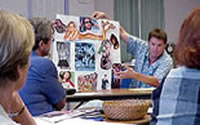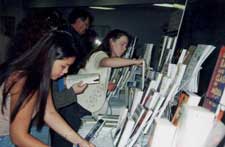WORKSHOP REPORT: Integrating Media Literacy Across the Curriculum
|
|
Report of CML's K-12 Professional Development Seminar conducted by Elizabeth Thoman, Founder, Center for Media Literacy
Report by Lisa Tripp, Ph.D. Candidate, Dept. of Communication, U. of California / San Diego
What does a plain white bath towel have to do with teaching language arts? Fifteen teachers from throughout Southern California plus the state of Kansas and the country of Japan, learned there were many connections between the two at a day-long professional development seminar Saturday, June 17, 2000, conducted by Elizabeth Thoman, founder and president of the Center for Media Literacy.
The latest in a series of seminars sponsored by CML's Felton Media Literacy Scholars Program and cosponsored by Unite L.A., the day's events included presentations, lively discussions, role-playing activities and brainstorming sessions. Throughout, participants delved into the nitty gritty details of incorporating media literacy into standards and frameworks for language arts, social studies, health, and other subject areas, examined resources for all grade levels, and developed ideas for lesson plans and activities for the elementary, middle school and high school classroom.
Participants included media industry professionals, school teachers, university researchers, and people working in the fields of teacher training and parent education. This diversity created a rich atmosphere for learning from each other. According to Lori Bergen, a professor from the A.Q. Miller School of Journalism and Mass Communication, Kansas State University, "what was particularly interesting to me was meeting so many different people that came to the concept of media literacy from so many different perspectives."
A Shared Foundation
The day got off to a strong start as Liz led us through a lively discussion of what the purpose of education should be - and what role media literacy could play. We discovered that we shared many goals in common, such as enabling students to think critically, to reason and problem solve using different sources of information, and to be active citizens in building a better society. This discussion of foundational goals helped set the tone for the seminar which Liz focused on three major curriculum areas: Language Arts, Social Studies, and Health Education.
 For each of these subject areas, we first discussed the essential tasks and questions that curriculum area should deal with and then strategized different ways that media literacy activities could help accomplish central curricular goals. We also reviewed official curriculum standards for the different subject areas across a variety of grade levels and then analyzed the connections to media literacy education that specific standards call for or suggest.
For each of these subject areas, we first discussed the essential tasks and questions that curriculum area should deal with and then strategized different ways that media literacy activities could help accomplish central curricular goals. We also reviewed official curriculum standards for the different subject areas across a variety of grade levels and then analyzed the connections to media literacy education that specific standards call for or suggest.
In California's standards for Language Arts, for example, students in grade four are supposed to learn to evaluate the role of media in focusing attention on events and in forming opinions on issues. In Social Studies, students in grade 12 are to be able to evaluate, take and defend positions on the influence of the media on American political life. And in Health Education, as another example, students in High School learn how to analyze the influence of advertising and marketing on the selection of healthful and nutritional products. Many participants were surprised to learn that so many school standards already in place suggest these kinds of openings for media literacy.
Note: For a major reference chart of curriculum connections to media literacy, state by state, visit Frank Baker's Media Literacy Clearinghouse website at www.frankwbaker.com/
 For each of the different subject areas, Liz also shared essential teaching resources, such as videos and curriculum programs, which the Center for Media Literacy recommends and distributes. Throughout, a number of teachers also shared first hand experience with successful ways that they have brought media and media literacy activities into different areas of the curriculum.
For each of the different subject areas, Liz also shared essential teaching resources, such as videos and curriculum programs, which the Center for Media Literacy recommends and distributes. Throughout, a number of teachers also shared first hand experience with successful ways that they have brought media and media literacy activities into different areas of the curriculum.
Learning By Doing
Some of the most memorable moments of the day came from everyone participating in role-playing activities which could potentially connect media literacy to lessons in the three curriculum areas.
Who would have thought, for example, that an ordinary white bath towel could help teach many skills in language arts!
But we quickly learned when we broke up into groups to form three ad hoc advertising agencies. Our task?: design and pitch an ad campaign to convince a target audience (children 3 to 6, girls 12 to 15, or high school gym teachers) that they just could not live without owning an ordinary plain white towel! Each group had a great time coming up with a campaign theme, slogan, strategy, and visuals to try and convince their target demographic that a White Towel was indispensable.
 According to one participant, "the activity was really effective at demonstrating how advertisers try to make different kinds of audiences want products they don't necessarily need… and I'm sure that my students will learn a lot from it." It also demonstrated how to help students practice many skills from the language arts repertoire, including writing and rewriting; understanding metaphors and visual language; storyboarding, and of course, listening, speaking and presentation skills. Team building and working collaboratively in cooperative work groups are also bonus skills in activities like this.
According to one participant, "the activity was really effective at demonstrating how advertisers try to make different kinds of audiences want products they don't necessarily need… and I'm sure that my students will learn a lot from it." It also demonstrated how to help students practice many skills from the language arts repertoire, including writing and rewriting; understanding metaphors and visual language; storyboarding, and of course, listening, speaking and presentation skills. Team building and working collaboratively in cooperative work groups are also bonus skills in activities like this.
In another activity, we explored the conventions of talk radio with Liz challenging us to role play the parts of a talk show 200 years ago when the subject of the day was discussing whether or not the colonies should secede from England! With different groups taking on the role of "caller", "screener" or "host", the activity proved to be a lively and interesting way for a class to cover complex issues in U.S. history, practice building political arguments, and, at the same time, learn more about the strengths and weaknesses of the talk radio format. With the elections coming up this fall, several teachers took note of how to conduct a similar exercise in their social studies classes.
 A Successful and Useful Seminar
A Successful and Useful Seminar
Participants left the seminar with a great deal of enthusiasm and new ideas for integrating media literacy throughout the curriculum. According to Jayne Nickels, a teacher at Longley Way School in the Arcadia School District, the day's events — "the activities, the role-playing and all the interactions" —gave her many ideas to try in her first time fifth grade class she'll be teaching in the fall. Elaine Liming, Mater Dei High School in Orange County, remarked, "There's a whole bunch of things that I put down in my notes and said to myself, now here's an idea I can develop!"
As in previous events sponsored by the Center, participants seemed especially pleased with the opportunity to meet, talk with, and learn from different people interested in media literacy. At the end of the day people lingered for a long time, exchanging phone numbers and continuing their animated conversations into the halls and parking lot. All of us will never forget how a simple white bath towel could open a magical door to integrating media literacy across the curriculum.



